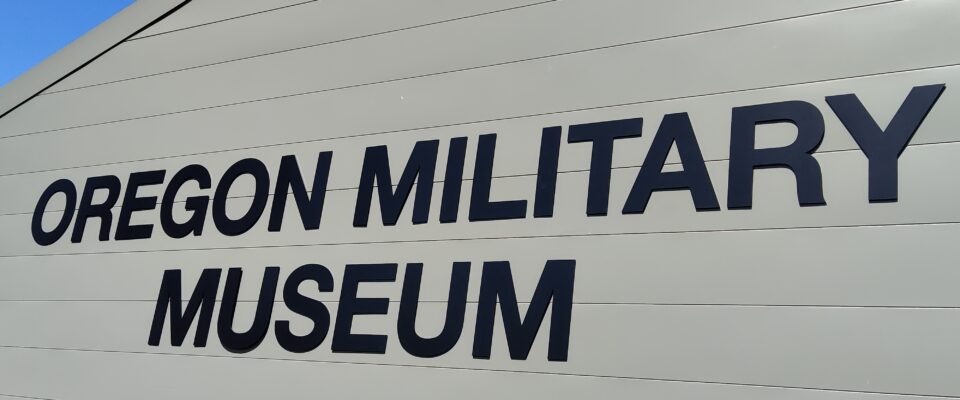Our Mission and History
The mission of the Oregon Military Museum is:
To inspire and educate visitors about Oregon’s military heritage and legacy to include the National Guard, the state’s early militia, and all branches of the Armed Forces
To meet its professional stewardship obligations for the historical artifacts and archives entrusted to its care
In 1975, the Oregon Military Department established the Oregon Military Museum as the official state repository for military weapons, documents, and artifacts relating to the military history of the citizens of Oregon. This collection of irreplaceable treasures defines Oregon’s military legacy, preserving it for future generations.
Until 2009, the Oregon Military Museum collections were housed and displayed in several buildings located at Camp Withycombe, including the 6,000 sq. ft. main facility, the 1911 Battery A Field Artillery Horse Barn, and the World War II Quonset Hut. As the result of a massive base realignment process, the Museum has relocated to the 32,000 sq. ft. old Clackamas Armory at Camp Withycombe. OMM’s move into the much larger building provides it with unique opportunities to expand operations as well as increased exhibition, collections care, program, and education spaces to better fulfill the Museum’s mission.
Evolution of the Oregon Military Museum
1909: Clackamas Rifle Range is established as a training camp for the Oregon National Guard (ONG), becoming the earliest organized firing range in the state of Oregon and one of the oldest in the western United States
1911: The Quartermaster Storehouse and Battery A Field Artillery Horse Barn are built at the Clackamas Rifle Range
1916: “Camp Withycombe” is first used to designate the Mexican Border Mobilization Camp at the Clackamas Rifle Range
1917: The Battery A Field Artillery Horse Barn is used to house officers’ horses, whose names are painted above each stall and remain visible over a century later
1934: Clackamas Rifle Range is designated as a federal military reservation and permanently renamed Camp Withycombe after Governor James Withycombe
1957: Future site of the Oregon Military Museum, the Clackamas Armory, otherwise known as the Camp Withycombe Armory, opens on post
1975: The Oregon National Guard Military Museum and Resource Center is established by the Oregon Military Department as the state’s official military history repository
1988: An ORNG detachment of 12 service members is created to support the Museum
1988: The Museum, housed in its own building for the first time after initially being housed within the Clackamas Armory, officially opens to the public with guided tours of collection items on display
1996: The Battery A Field Artillery Horse Barn officially becomes part of the Museum and displays artillery for the first time to the public
2001: Senate Bill 635 transforms the Oregon National Guard Military Museum and Resource Center into an all-forces museum, renaming it the Oregon Military Museum (OMM)
2008: After being open to the public for over 30 years, OMM closes for Base Realignment and Closure (BRAC), making space for the 41st Infantry Division Armed Forces Reserve Center (AFRC)
2009: The Oregon Military Museum moves into its current location, as well as the Museum’s 1975 initial home, and begins the process of renovating and expanding the Camp Withycombe Armory to retrofit the building as a 21st century museum
2009: The Battery A Field Artillery Horse Barn moves to the Museum’s new Historic Park area, anchoring the Park for future additions
2009: OMM moves its WW2 era Quonset Hut (Q-Hut), once used on post by soldiers and later by the former Oregon Military Museum Foundation, into its Historic Park
2014: The Quartermaster Storehouse, one of the first structures built on Camp Withycombe and recently acquired by the Museum, moves to its current location in the Historic Park after nearly being demolished
2016: The Museum’s detachment deactivates with the retirement of Chief Warrant Officer Robert Ryan and transitions to a corps of skilled restoration volunteers
2019: All elements of the Oregon Military Museum’s Historic Park are in place — the Battery A Field Artillery Horse Barn, the Quartermaster Storehouse, and the newly-installed multi-tank display
2019: OMM marks 10 years since closure to the public while it continues to unpack from the 2009 move and manage building renovations, along with continuing collections care, restorations, and research services
2019: Renovation of the Quartermaster Storehouse as an interpretive center is completed but not yet open to the public
2020: OMM’s main building remodel is completed, including renovations of the drill floor, mess hall, and rifle range into an exhibit gallery space; the installation of the Thomas E. Withycombe Library; and the addition of the lobby and Hall of Valor
2021: The Museum’s permanent collections surpass 15,000 artifacts, including 50 vehicles, 1,300 uniforms, 750 small arms, 410 pieces of art, and 1,000 demilitarized ordinances while the Library holds over 35,000 publications and 1,000 cubic feet of archives, audiovisuals, and photos
2022: OMM opens its Historic Park to the public for the first time with a weekly schedule, including a wider array of programs and services with the help of a growing Volunteer Corps
2022: OMM begins design of its first generation and rotating exhibits while hosting outreach events in its renovated building
2022: The Museum becomes the official repository for the 41st Infantry Division
2025: The Oregon Military Museum celebrates its 50th anniversary as an established museum and the state’s official military history repository

